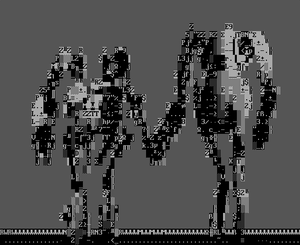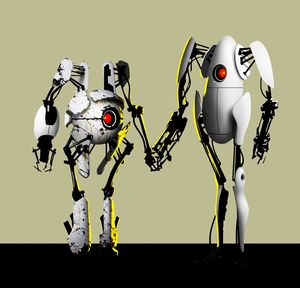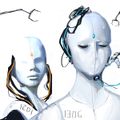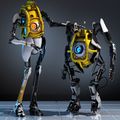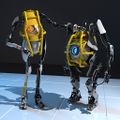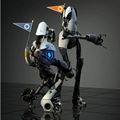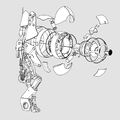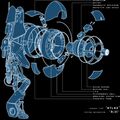ATLAS and P-body
| Warning! This article has yet to be cleaned up to a higher standard of quality, per our Cleanup Project. It may contain factual errors and nonsense, as well as spelling, grammar and structure issues, or simply structure problems. Reader's discretion is advised until fixing is done. | ||
|---|---|---|
You can help clean up this page by correcting spelling and grammar, removing factual errors and rewriting sections to ensure they are clear and concise, and moving some elements when appropriate. |
| This article would greatly benefit from the addition of one or more new images. | ||
|---|---|---|
Please upload one or several relevant images (from canonical / official sources) and place it here. Once finished, this notice may be removed. |
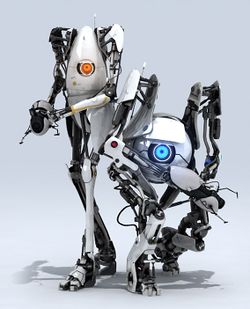
| |
| ATLAS and P-body | |
|---|---|
| Biographical information | |
| Homeworld |
Earth |
| Function(s) / Belongings | |
| Rank / Occupation |
|
| Weapons | |
| Physical description | |
| Nature |
Modified Personality Constructs |
| Gender |
|
| Eye color |
|
| Chronological and political information | |
| Era(s) | |
| Faction | |
| Game information | |
| Voiced by | |
| Designer(s) |
|
| Entity |
player |
ATLAS and P-body, referred to as Blue and Orange by GLaDOS, are a pair of Robotic Associates[3] (bipedal Personality Construct-based androids) that are playable characters in Portal 2’s cooperative campaign.[4]
Designed by GLaDOS sometime during the single-player campaign, they are assigned the task of completing the Cooperative Testing Initiative in the Aperture Science Enrichment Center, previously uncompleted by human Test Subjects.[5]
Gameplay-wise, ATLAS is played by the host of the co-op session (the player who sends an invitation), while P-Body is played by the guest (the player who accepts an invitation). PlayStation 3 players are automatically assigned as the host during cross-platform games to prevent use of the console by the PC player.
Contents
Biography[edit]
Appearances[edit]
Portal 2[edit]
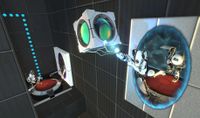
Single-player[edit]
In the final levels of the single-player story of Portal 2, Wheatley discovers ATLAS and P-body while searching for other test subjects, as he believes Chell has been killed by his clumsiness. He then decides that he does not need Chell anymore, and attempts to kill her in a death trap. During the trap, GLaDOS; in her potato form, states that she created the robots to phase out human testing just before Chell escaped, and justifies it by reminding Chell that she did kill her. Because of this, it is assumed that the escape she mentions is the second escape earlier, in Portal 2, where Wheatley helped her escape, rather than the first in Portal, as Chell had yet to kill, or even meet, GLaDOS at that point. After Wheatley is defeated and sent into space, GLaDOS re-assumes control of the facility, and summons ATLAS and P-body, who can be seen greeting Chell when she re-awakens after being unconscious from her trip to space.
Co-op[edit]
After giving Chell her freedom, GLaDOS then turns onto testing the robots. She first sends them through Calibration, in where she emphasizes the importance of teamwork in the tests, but also gives the first implications that it is a competition between them. They also rapidly starts gesturing, which annoys her, stating that the behavior is human-like. After Calibration, she then sends the robots through four test courses, each introducing new testing elements to challenge them.
At the end of the Team Building test course, she rebuilds ATLAS and P-body outside of the official testing tracks, simply briefing them that "This test is so outside the box, that I can't- I mean- won't even tell you what it's about". The two then proceed into a control room with a projector. A whiteboard displays the message, "DO NOT TRUST HER." Since the bots were designed not to think, the warning is ignored. ATLAS and P-body find a large disc and load it into the computer, which secretly grants her further control over the Enrichment Center. GLaDOS then reveals that the only way for her to bring the two back into the Hub, is to initiate their self-destruct sequence, then taunts them about their inability to communicate with one another the pain they feel. If the robots persist in making gestures rather than search for their objective, GLaDOS, angered, threatens to deduct 50 to 5,000 of their Science Collaboration Points.
It later becomes apparent that at the end of each testing course, she would send them outside the testing tracks, to serve as her minions without their knowledge. Through the rest of the three test courses GLaDOS trains ATLAS and P-body to expertly maneuver through their surroundings, which will be necessary to succeed in her true objective. After the bots have installed the remaining three discs into their respective inputs, GLaDOS states that "[she] can see everything now", then initiates ATLAS's and P-Body's self-destruct sequences. They are rebuilt inside the Hub where they are briefed on a new testing course, as GLaDOS moves the entrance to the course into the Hub.
ATLAS and P-body are dropped into the depths of the Enrichment Center, where they are sent to the unnamed Test Shaft, originally constructed by Aperture in the 1950s-70s era. She instructs them to make their way to the human vault at the end of the test. GLaDOS states that conducting tests on ATLAS and P-body, despite their being more loyal to her than any other Test Subject(s), is not as rewarding to her as testing humans, as human fear provides her with an endless source of satisfaction.[6] She also reveals that the Test Shaft was used to train them for the challenges awaiting them near the Human Vault. On their way to the Human Vault, a reprogrammed Defective Turret can be seen trying to defend the humans, indicating that some survivors of GLaDOS's original attack on the Aperture scientists and employees (with a neurotoxin) had crawled down there.
When ATLAS and P-body reach the Human Vault, it is discovered, to GLaDOS's chagrin, that vault can only be unlocked by specific gestures. GLaDOS convinces ATLAS and P-body to perform the gestures. With the vault successfully unlocked, ATLAS and P-body discover it houses hundreds, if not thousands, of human Test Subjects "stored" in Stasis Chambers. Though prone to brain damage from long-term stasis (decades longer than Chell's), GLaDOS, having achieved her true objective - human test subjects, gladly extracts them from the vault and begins examining their profiles while the humans are prepped for testing. Cooperative campaign's ending credits roll.
Peer Review[edit]
GLaDOS reassembles ATLAS and P-Body, informing them that they are 100,000 years in the future, where testing is just a form of art. After they explore several of her "exhibits", the disassemblers break down and she reveals that it's only been a week, all the humans are dead, and someone else has plugged themself into an old GLaDOS chassis and is trying to take over the facility.
As the facility continues to break down, GLaDOS tries to turn ATLAS and P-Body into "killing machines" by provoking and insulting them. Even though this fails, she sends them to inspect the old chassis anyway and murder whoever has taken it over, because the reassembly machines are failing.
ATLAS and P-Body enter the old chassis room to find that the bird from the single-player campaign is making a nest in the chassis. Although GLaDOS, suffering from a phobia of birds, urges the robots to retreat, they succeed in shooing the bird out of the facility. GLaDOS then hatches the eggs in a specially-built relaxation vault, and begins to treat the newborn birds as test subjects, observing that they are the perfect "killing machines".
The Lab[edit]
|
Both ATLAS and P-body appear in The Lab’s sixth minigame, Robot Repair. ATLAS is supposed to be repaired while P-body pretends to be reading a magazine in the waiting room.
Aperture Hand Lab[edit]
|
The game is played from the point of view of an ATLAS / P-body robot. Furthermore, three ATLAS robots are featured on a safety poster in the elevator, and P-body is briefly seen playing golf on another training platform below.
Appearance[edit]
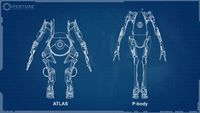
The robots were designed from scraps. ATLAS' design is based on a Personality Core, while P-body is based on a Sentry Turret.[1] To facilitate their humanization, they were given their own personalities, and clearly anthropomorphic designs and behaviors. Gender-wise, the robots have their own sex, as stated by Chet Faliszek in an interview (ATLAS as male, P-body as female).[7]
Each robot has its own Aperture Science Handheld Portal Device that bears the color of its user (blue for ATLAS, orange for P-body), as two lines running along the barrel. Each robot's portal gun produces two distinct colors of portal (ATLAS' are blue (primary) and violet (secondary); P-body's are yellow (primary) and red (secondary)). Both pairs of portals can exist at once, and either can pass through each others' portals, a vital means of completing the tests. They are respawned through Vital Apparatus Vents if destroyed. Duplicate robots are constantly built by automated machines, apparently keeping the memories and behavior of the previous incarnations.
Their heads function independently of their bodies, allowing them to control their limbs even if it is removed, although it renders them blind. This implies that their brains are in the bodies, rather than their head. This aspect of their design allows them to play pranks on each other by taking or knocking off their heads. They also have a night vision function in their eyes, although they apparently cannot control this themselves, only GLaDOS can activate and de-activate it remotely.
Personality and skills[edit]
As said above, the robots were designed with anthropomorphic personalities to facilitate their humanization. These personalities are expected to develop during the course of the game.
Examples of anthropomorphism go from simple to complex behaviors. For instance, the results of the Aperture Science Collaborative Disposition Test tell that ATLAS is brave and fearless, willing to take on any challenge, while P-body is inquisitive and sensitive, examining the situation with care before proceeding, however, the co-op intro shows the opposite. Both value friendship, making them the ideal testing partners.
To a degree, they appear to being affected by GLaDOS' opinion on some matters. This is shown in Peer Review, when they discover the bird, as GLaDOS panics, exaggerating the birds danger. P-body appears to be daunted by these warnings, hanging back while ATLAS bravely approaches the bird to attack it. This behavior matches the personalities given in the Collaborative Disposition Test.
Other anthropomorphic behaviors include: making gestures to each other to indicate the other what to do or where to go; using some form of speech embodied by an apparently unintelligible robotic chatter (ATLAS having a masculine voice, P-body having a more feminine voice); using portals for fun and not only for testing; using some form of laughter; playing rock-paper-scissors; and hugging each other. Co-operative work also requires them to trust each other, and they undergo tests for that purpose. However, they eventually develop a tendency to betray each other (like humans), and in the end trust each other only 6 seconds longer than humans.[8]
The skills and personality are obviously influenced by the players' behavior toward each other. Tests or achievements require being selfless as much as being selfish.
Behind the scenes[edit]
- ATLAS and P-body, as well as the Cooperative Testing Initiative, were first introduced during the Portal ARG, in one of the ASCII art images given by the BBS. In that image, actually concept art for Portal 2, ATLAS is holding an Aperture Science Handheld Portal Device, and they hold each others' hands: this gesture is said to be a sign of innocence more than an indication of romance between the two, and also describes the whole co-op idea, that Portal 2 also means playing with a friend.[1] The ARG also revealed through the Aperture Image Format program two images referring to the completion of the trial phase of the Aperture Science Cooperative Testing Initiative, referring to Portal 2’s co-op mode. Their second appearance is at the very start of the "Portal is Free" video promoting Portal being free from May 12 to May 24, 2010, where they can be seen within the isometric offices in a small room on the bottom right. They then appeared in a teaser for the co-op mode of Portal 2 shown at Gamescom 2010, in a dramatized version of an example of co-op gameplay, where ATLAS elbows P-body so that it subjects itself to ATLAS's portal to be sent thanks to momentum to a button located beyond a trap and allowing the completion of the Test Chamber. In the video, they appear to use some form of speech, consisting of computer-like sounds. They then appeared in the full version of the co-op trailer and other variants of it, and weekly videos leading up to Portal 2's release, such as a TV spot, Aperture Investment Opportunity #1: "Panels", and Aperture Investment Opportunity #2: "Bot Trust".
- Originally, the two Portal 2 co-op characters were to be human females, with player one being Chell, and player two being a new character named Mel. They were replaced by robots in order to create an in-universe reason for the characters respawning after death,[9] and making them the first playable robot characters in the Half-Life and Portal universe.
- At the early stages of Portal 2 development, there was competitive multiplayer feature, but the idea was scrapped.[10]
- As seen in other concept art images, the two robots have come through several other iterations, including color variants, and more humanoid appearances,[11] with influences from the film Westworld, as the team at some point wanted them to look human and feel robotic at the same time.[1] As seen in more recent concept art, they also originally both had a red eye, later changed to orange for P-body and blue for ATLAS.
- When the website ApertureScience.com was updated for Portal 2, the Garden Gnome from the alternate Christmas video was replaced by a nervous P-body.
- The robot names are apparently a reference to their body shapes, though this has not been confirmed yet. ATLAS may be related to the Titan of the same name, which is often represented as supporting Earth on his back, a task which would be eased by the size of ATLAS' shoulders. Another way it could be represented is the fact that both the Mythical Atlas and ATLAS carry a spherical object; the mythical one carries the earth, while ATLAS carries a personality core. "ATLAS" being written in caps, this may also be an acronym of a currently unknown significance. P-body's name, meanwhile, refers to a label on its back describing the robot's "Frame Type" as "P". It may be a pun on "pea body", the robot's body shape somewhat resembling a pea pod.
- The robots are referred as "ballbot" (ATLAS) and "eggbot" (P-body) in game files.
- Three custom skins are available for those who pre-ordered or buy the retail version of Portal 2, depending on the place of purchase.
- Roll Cage (featured in the informational video Aperture Investment Opportunity #2: "Bot Trust"): pre-ordering through GameStop (USA) or EB Games (Australia).
- Paint Job: pre-ordering through Amazon.de (Germany), Amazon.fr (worldwide) or CDON.com (Sweden, Denmark, Norway, Finland).
- Antenna Topper: pre-ordering through Fnac (France), Webhallen (Sweden), Alcom (Swiss) or Softridge (Swiss), buying retail version in Russia or CIS.
- Several unused P-body textures can be found in Portal 2 game files: white dirty, white clean, blue and red, possibly used by placeholder robots model (not existing in game files). The red light can be seen on the textures.
- One of the original ideas for the Peer Review DLC, was a single-player campaign following one of ATLAS and P-body teaming up with the Adventure Sphere, who were to encounter the AI of Cave Johnson, and even a segment set in outer space with the Space Core. However, this was abandoned due to lack of resources, and the team instead focused on a new co-op course.[12]
Trivia[edit]
- P-body makes a cameo appearance during the single player campaign, in Chapter 8: The Itch. In Test Chamber 15 of Wheatley's testing track, Wheatley attempts to make an exit chamber for Chell, P-body can briefly be seen. She panics before running out through the door.[13]
- In the developer commentary, it is stated that ATLAS was constructed well before P-body.
- ATLAS' first scene in the Bot Trust video, where he smashes himself with a frying pan, is a reference to the pancake-flipping robot arm.
- In Peer Review, the robots briefly pass through an abandoned area containing several unused parts of their bodies, such as heads and arms, as well as several posters encouraging human-robot co-operation. What this area was used for, and whether it was related to a preliminary construction of the robots, is currently unknown.
Gallery[edit]
Pre-release[edit]
Concept art[edit]
Screenshots[edit]
The two robots in the Hub.
P-body seen on the ApertureScience.com website, in place of the Garden Gnome.
ATLAS and P-body blueprints, as seen in the video Aperture Investment Opportunity #2: "Bot Trust".
Retail[edit]
Chell's encounters with ATLAS and P-body in the Central AI Chamber.
Other[edit]
Portal: The Uncooperative Cake Acquisition Game ATLAS and P-body card.
Aperture Science Collaborative Disposition Test P-Body art.
List of appearances[edit]
Main games[edit]
Other[edit]
- Portal ARG (First appearance)
- ApertureScience.com (Non-canonical appearance) (P-body only)
- PotatoFoolsDay ARG
- The Final Hours of Portal 2
- Robot Repair
- The Lab (Non-canonical appearance)
- Portal Pinball (Non-canonical appearance)
- Portal: The Uncooperative Cake Acquisition Game (Non-canonical appearance)
- Lego Dimensions (Non-canonical appearance)
- Aperture Hand Lab (Non-canonical appearance)
References[edit]
- ↑ 1.0 1.1 1.2 1.3 Redesigning Portal: Valve’s Artist Speaks on Game Informer (March 22, 2010) (archived)
- ↑ Karen Prell - Video Games on KarenPrell.com (archived)
- ↑ Peer Review
- ↑ GameInformer's Portal 2 Hub on Game Informer (April 2010) (archived)
- ↑
 Portal 2 Full Co-op Trailer on YouTube
Portal 2 Full Co-op Trailer on YouTube
- ↑ Portal 2 - Chet Faliszek Q&A Feature on TotalVideoGames.com (January 24, 2011) (archived)
- ↑ How Valve Opened Up Portal 2 - Interview (Page 2) on Eurogamer
- ↑
 Aperture Investment Opportunity #2: Bot Trust on YouTube
Aperture Investment Opportunity #2: Bot Trust on YouTube
- ↑ Preview: Portal 2 (co-op) on Joystiq (June 21, 2010) (archived)
- ↑ This is what Portal 2's competitive multiplayer looked like (and other cut concepts) on ShackNews (March 8, 2012)
- ↑ Valve Studio Tour: From Old To New on Game Informer (March 29, 2010) (archived)
- ↑ The Final Hours of Portal 2
- ↑
 P-body in Test Chamber 15 on YouTube
P-body in Test Chamber 15 on YouTube

